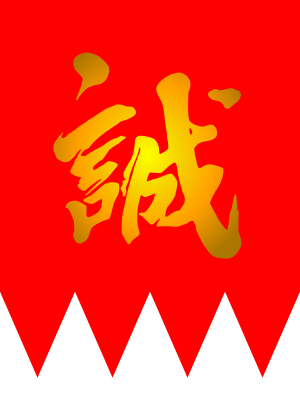Shinsengumi facts for kids
Quick facts for kids Shinsengumi |
|
|---|---|
| 新選組 | |

Flag of Shinsengumi
|
|
| Active | August 18, 1863 |
| Country | Kyoto, Japan |
| Allegiance | Tokugawa bakufu |
| Branch | Rōshigumi (disbanded in 1863) |
| Type | special police |
| Role | To protect the Tokugawa bakufu representatives and Kyoto |
| Size | 302 |
| Colors | light blue, white |
| Engagements | Ikedaya incident Kinmon incident Zenzaiya incident Akebonotei incident Sanjo Seisatsu incident Aburanokōji incident Tenmaya incident Boshin War: |
| Disbanded | June 23, 1869 |
| Commanders | |
| Notable commanders |
Serizawa Kamo (1863) Kondō Isami (1863–1868) Tonouchi Yoshio (1863) Hijikata Toshizō (1868–1869) Sōma Kazue (1869) |
The Shinsengumi was a special police force in Japan during the Edo period. This was a time when Japan was ruled by the Tokugawa shogunate. The Shinsengumi was formed to protect the city of Kyoto and the shogunate's leaders.
They were created by Katamori Matsudaira, a powerful lord from the Aizu region. Their main job was to keep peace and order in Kyoto. They also protected the shogunate from groups who wanted to change the government.
Contents
What Was the Shinsengumi?
The Shinsengumi was like a special police unit. They were made up of skilled swordsmen. Their main goal was to support the Tokugawa shogunate. This government had ruled Japan for over 250 years.
They wore distinctive light blue uniforms. These uniforms had white triangle patterns. They were known for their strict rules and fierce loyalty.
Why Were They Formed?
In the mid-1800s, Japan was changing. Many people wanted to restore the Emperor to full power. They also wanted to open Japan to the rest of the world. The Tokugawa shogunate wanted to keep things as they were.
Kyoto was a very important city. It was often a place where these opposing groups clashed. The Shinsengumi was formed to keep order in Kyoto. They also hunted down those who opposed the shogunate.
Famous Moments
The Shinsengumi became very famous after the Ikedaya Incident in 1864. They discovered a plot by anti-shogunate rebels. These rebels planned to set fire to Kyoto. The Shinsengumi raided the Ikedaya Inn. They stopped the plot and saved the city. This event made them heroes to the shogunate. It also made them feared by their enemies.
They were involved in many other smaller conflicts. These battles were often against groups who wanted to overthrow the shogunate. The Shinsengumi fought bravely to protect the old ways.
Key Leaders
The Shinsengumi had several important leaders.
- Kondō Isami: He was the main leader of the Shinsengumi for most of its history. He was a skilled swordsman and a strong leader.
- Hijikata Toshizō: He was Kondō's second-in-command. He was known for his strict rules and clever strategies. He was often called the "Demon Vice-Commander."
- Saitō Hajime: He was one of the Shinsengumi's section commanders. He was a very skilled fighter. He survived the conflicts and later became a police officer.
The End of an Era
The power of the Tokugawa shogunate began to weaken. A new government took over in what is called the Meiji Restoration. This was a big change for Japan. The Shinsengumi continued to fight for the shogunate. They became part of the shogunate's army.
They fought in the Boshin War, a civil war in Japan. This war was between the old shogunate and the new imperial government. Kondō Isami was captured and executed by the new government. Hijikata Toshizō continued to fight until the very end. He was killed in battle in 1869.
Even though the Shinsengumi was defeated, they are remembered as a group of loyal and brave warriors. They fought for what they believed in during a time of great change in Japan.
Images for kids
-
Ancient Kondō Isami's quarters at Nagareyama Chiba Prefecture, Japan. One of the former Shinsengumi headquarters
-
Coat of mail and helmet of Kondō Isami
See also
 In Spanish: Shinsengumi para niños
In Spanish: Shinsengumi para niños





